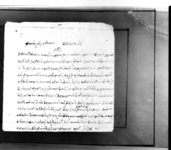A purjī from the Guṭhī Bandobasta Aḍḍā to the Kausī Tosākhānā requesting a disbursement of funds for installing a new Kumārī (VS 1980)
ID: K_0214_0045
Edited and
translated by Astrid Zotter
in collaboration with
Raju Rimal
Created: 2018-10-15;
Last modified: 2019-05-28
For the metadata of the document, click here
The accompanying edition, translation/synopsis and/or commentary are available under the terms of the Creative Commons Attribution-ShareAlike 4.0 International License
Abstract
This purjī issued by the Guṭhī Bandobasta Aḍḍā supports the claim of the pūjārī Vimalāramaṇa Rājopādhyā to material provisions for installing a new Kumārī to be worshipped during Baḍādasaĩ at the Patan Taleju temple as being a rightful one. The Kausī Tosākhānā is requested to disburse Rs. 9.25 for clothing.Diplomatic edition
[1r]
1⟪12⟫1श्री५सर्कारतर्फगुठीवंडोवस्तवाट कौसीतोसाषानाके2पुर्जी
3उप्रांत•पाटंश्रीतलेज्युमावडाडसैकोपुजामारअरुपर्वपर्वमास्मेट्पुजागर्नुपर्नेश्रीकुमारी७६साल्मा
4षुन्भैफेर्डागुल्वंडकोलहंगा१वापत्तातीन्षाप्कोचोलो१लालकपडाकोपछ्यौरा१
5स्मेट्कोकौसीतोसाषानावाटमोरु९।२५भोज्कोचाहीनेठेकडारवाटमोरु२०।स्मेट्ज्मामोरु२९।२५
6षर्चगरीस्थापनाभयेकोमाहाल्सोकुमारीकोडाट्झरीषुन्भयाकोलेयो८०साल्कोवडाडसै
7लाईअर्कोनञाकुमारीस्थापनागर्नुपर्नेभयेकोलेजाहेरगरेकोछुसावीक्वमोजींपाऊभंनेस्मेट्वे
8होराकोपुजारीवीमलारमणराजोपाध्याकोजाहेरीदर्षाष्येस्अडामाडीयेकोलेवुझडादर्षाषका
9वेहोरावाटसापोसाक्वापट्मोरु९।२५तेस्अडाव़ाटपायेकोभंनेलेषीयेकोदेषीनालेसोडर्षाष्
10वमोजींकोषर्चचाहीनेमध्येतेस्अडावाटपाऊनेभनीलेषीयाकोसोमोरु९।२५कोहकमालेषनेकां
11भयेकोछतसर्थमाठीलेषीयाकोवेहोरावुझीसोकुमारीफेर्डा⟪लेषीयेवमोजीं⟫पोसाक्केमोरु२।९।२५नौरुपैञा
12पचीस्पैसातेस्अडावाटजानेडरवंडीसनद्भये सोमोरु९।२५माठीलेषीहाल्षुन्भै[?]अरु
13अर्कोकुमारीस्थापनागर्नालाईपनिमोरु९।२५नौरुपैञापचीस्पैसाऐसव़ाल्कोरीट्पुर्याई
14नीज्पुजारीहस्तेडीनेकांभयावेस्होलासं८०साल्आश्वीं गतेरोज् शु¯¯¯¯¯¯¯¯¯
Translation
[1r]
121
From the Guṭhī Bandobasta [Aḍḍā] under Śrī 5 Sarkāra to the Kausī Tosākhānā
Uprānta: "When the Śrī Kumārī to be worshipped during the pūjā [on the occasion] of Baḍādasaĩ at the Pāṭaṃ Śrī Talejyū [temple] and during other festivals was replaced in the year [VS 19]76 after blood had appeared, the installation ritual was [performed] at a total cost of 29.25 mo[hara]rū[paiyā̃]s—9.25 morus from the Kausī Tosākhānā for 1 lower garment (lahãgā) of gulbanda2 fabric, 1 three-layered blouse (colo) [made of] bāpatā fabric, 1 headscarf (pachyaurā) of red fabric; together with 20 morus from contractors (ṭhekadāra), which [sum was] needed for the feast. Blood appeared when recently this Kumārī's tooth fell out, [and so] another new Kumārī needs to be installed for the Baḍādasaĩ this year, [VS 19]80, wherefore I [now] inform [you of this]. [I request that I] may receive [the necessary funds] in accordance with what is usual." — The pujārīVimalāramaṇa Rājopādhyā has submitted an application (ḍarṣāṣ for darkhāsta) for approval at our (lit. "this") office (i.e. the the Guṭhī Bandobasta Aḍḍā) with the details quoted; [and] when [the application] was being gone over (lit. "understood") it was seen from the details of the application that it was recorded that 9.25 morus for clothing was received from your (lit. "that") office (i.e. the Kausī Tosākhānā). The task [of the Guṭhī Bandobasta Aḍḍā] is thus to write on behalf of the claim (haka) to these 9.25 morus, which are recorded among what needs to be received as, according to that darkhāsta, [coming] from your office.
In cognizance of the details written above, therefore, if there is a list of rates (darbandī) [and] a sanada [allowing]—according to what is written [concerning] when this Kumārī is replaced—9.25 morus for clothing to be disbursed (lit. "go") from your office, it would be good, again [in the present case], to put 9.25 morus—[in words] nine rupees, twenty-five paisās—into the hands of the said pujārī for installing another Kumārī after recently blood appeared, and [thereby] observe the common practice in accordance with the law (ain) and administrative regulations ( savāla).
... day3 , the ...4 solar day (gate) of Āśvina of the [Vikrama] era year [19]80 (1923 CE). Auspiciousness.
Commentary
The scribe of this document, who also seems to have written the related document K_0214_0046, uses the same akṣara (most closely resembling a ḍa) to represent the unanspirated soft stop of both dentals and retroflexes. For dental -ta, too, -ṭa at times is used (e.g. in smeṭ or rīṭ).
This document is part of a batch of four documents, including the application (darkhāsta) to the Guṭhī Bandobasta Aḍḍā submitted by Vimalāramaṇa Rājopādhyā (K_0214_0044) and the documents meant to be sent by that office to the Kausī Tosākhānā (K_0214_0045, K_0214_0047) and to the Guṭhī Kharca Aḍḍā (K_0214_0046). Given the fact that the last three documents contain neither seals nor fully detailed dates, not to mention the presence of many corrections in K_0214_0045 and K_0214_0046, one may infer that they were internal drafts from which the real purjīs sent out from the Guṭhī Bandobasta Aḍḍā were to be prepared.
For further thoughts on the case at hand, see the Commentary to K_0214_0044.

